Ijraset Journal For Research in Applied Science and Engineering Technology
- Home / Ijraset
- On This Page
- Abstract
- Introduction
- Conclusion
- References
- Copyright
Smart Grid Integration Using IoT
Authors: Ajith M, Pranav Anil, Vishnu V Pavithran, Mumina K K
DOI Link: https://doi.org/10.22214/ijraset.2025.66933
Certificate: View Certificate
Abstract
Smart Grids are advanced systems combining flexible electric grids, communication, and IT to monitor and control energy flow in real-time from production to utility areas. They effectively integrate transfer and distribution systems, customer and renewable integration, and intelligent solutions to measure and manage energy usage. Electricity is vital for modern life, traditionally measured manually by TNEB personnel. We propose an IoT-based power meter for TNEB customers to automate this process by measuring energy consumption and uploading data to the cloud using ESP 8266. As fossil fuel resources deplete, Smart Grids, utilizing IoT for extensive information sensing, transmission, and processing, offer a promising solution. This paper reviews IoT integration in Smart Grids, discussing four-layered and web-enabled architectures and the enhancement of SCADA systems with cloud computing for Big Data management. Smart Grids are set to revolutionize electric grids by addressing energy consumption, waste, and grid reliability and security.
Introduction
I. INTRODUCTION
In today's rapidly evolving technological era, the Internet of Things (IoT) enables smart devices to interconnect via high-speed internet, facilitating real-time applications without human intervention. These devices, equipped with embedded technology, interface with sensors or controllers to communicate seamlessly. The Central Processing Unit (CPU) manages all interfaces and decision-making processes within an IoT system. Identification of each device is critical for optimizing system efficiency. IoT systems merge operational technology (smart devices interfaced by sensors and controllers) and information technology (data handling, storage, transmission, and security). Smart Grids, essential for smart cities, exemplify this convergence by generating and distributing electricity under monitored conditions. By integrating IoT with smart meters, consumers can monitor and limit their energy consumption, adapting to fluctuating electricity demands throughout the year. Advanced analytics and sensors enable detection of distribution losses and estimation of future energy requirements, enhancing reliability and efficiency. Continuous advancements in technology make smart grid implementation one of the largest IoT applications.Electricity, as the primary power source for various devices, is crucial for modern life. With fossil fuel reserves depleting, Smart Grids offer a sustainable solution. They provide a dynamic infrastructure for power generation and distribution, integrating renewable energy sources. Smart Grids improve efficiency and reliability, reducing carbon emissions and supporting sustainable development. Information and communication technologies, particularly IoT, play a vital role in this transition. By connecting sensors and devices, IoT ensures efficient data processing and enhances grid functionality. A well-functioning smart grid supports economic development by optimizing energy conversion and usage, contributing to a greener future.
II. SMART GRID
Smart Grid is a modern electrical grid concept as shown in Fig 1 under development since 2007, with intensive efforts in America and Europe. In the USA, it’s led by the Department of Energy (DOE) and EPRI through the "Intelligent Grid" project, focusing on enhancing power grid reliability and consumer service via computer communication. The DOE also collaborates with the industrial sector through the Grid wise program, which defines smart grid communication designs, standards, and technologies.
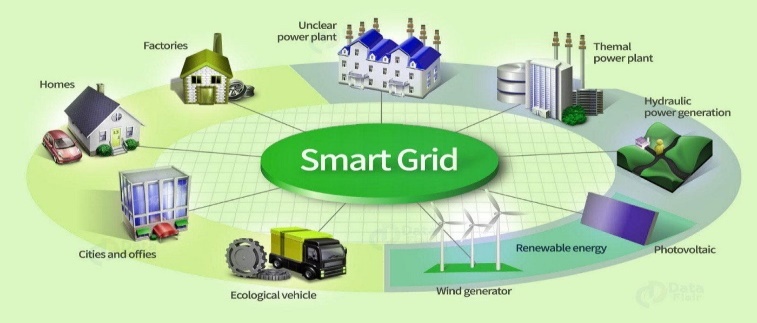
Fig.1. Smart Grid
The European Smart Grid Technology Platform envisions a flexible, accessible, reliable, and economical power system network. Key requirements include cost-effective technical solutions, harmonized regulations, and integration of all energy sources. In Indonesia, Smart Grid development aims to meet the projected 457-Terawatt Hour (TWh) energy demand by 2025, managing distribution through sensors and software. Although definitions vary, Smart Grids generally use two-way IT and secure cyber communication to integrate electrical systems from generators to consumers. Defined by DOE as a power system leveraging sensing technology, communications, digital control, and IT for dynamic management, and by the IEC as an efficient, sustainable, and safe electricity network, Smart Grids address power supply feasibility and reliability challenges. They aim to improve system efficiency, ensuring high reliability and safety from interference, driven by the inefficiencies of existing systems.
III. IOT
The concept of the Internet of Things (IoT) emerged in 1999 with the development of Radio Frequency Identification (RFID) technology. Today, IoT as shown in Fig. 2 is highly relevant due to advancements in ubiquitous communications, cellular devices, data analysis, and cloud computing. IoT refers to a network of interconnected devices that communicate and share information through public or private Internet Protocol (IP) networks. These devices collect massive amounts of data, which are analyzed for various purposes, including planning, management, and decision-making.
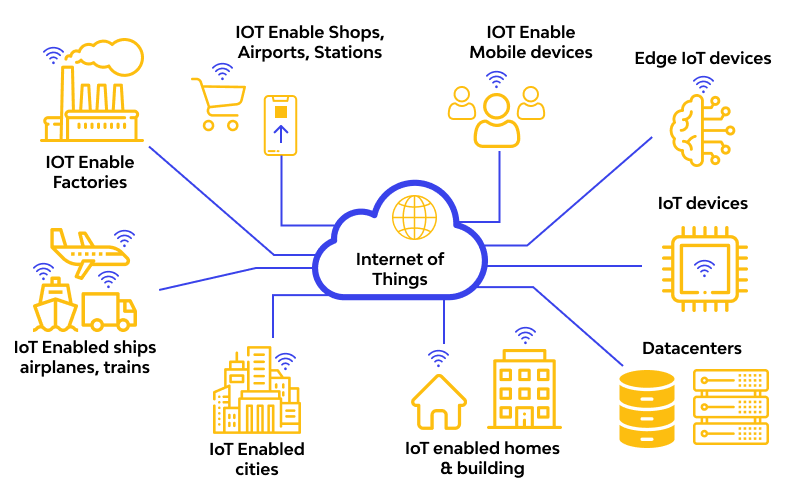
Fig.2. IoT
IoT encompasses a wide range of devices, from smartphones and household appliances to medical devices and industrial systems, all connected to achieve intelligent organization, security, and real-time monitoring. Enabling technologies for IoT include sensor networks, GSM, GPRS, 2G/3G/4G, Wi-Fi, GPS, RFID, microcontrollers, and microprocessors. IoT integrates information technology (hardware and software for data processing) and communication technology (systems for object communication) to meet application requirements like reliability, speed, security, and energy efficiency. IoT applications span numerous domains, including lifestyle, retail, agriculture, factories, transportation, buildings, cities, culture, tourism, emergency, healthcare, user interaction, environment, and energy. In Smart Grids, IoT is used to gather information from equipment, monitor equipment conditions, and control grid operations through application interfaces.
IV. METHODOLOGY FOR INTEGRATING IoT INTO SMART GRID
The Smart Grid employs advanced methods for retrieving, transmitting, and processing information, integrating various network functions. IoT technology enhances these capabilities by enabling real-time connections between users and devices through diverse communication technologies. This two-way data sharing as shown in Fig. 3 is fast and efficient, significantly improving Smart Grid operations. While the integration of IoT in Smart Grid systems has been established, the full potential for instantaneous knowledge and large-scale data processing remains underutilized.
IoT applications within the Smart Grid encompass areas such as dynamic scheduling for home energy consumption, electricity monitoring, system maintenance, demand management, and the management of electric vehicle charging and parking.
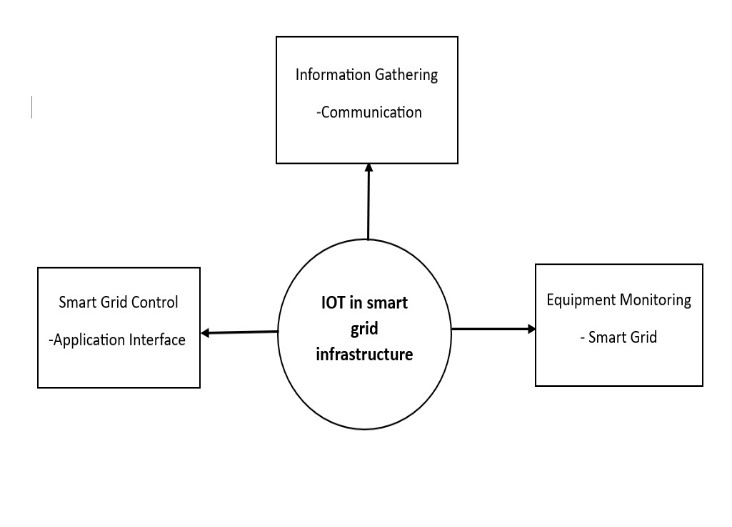
Fig.3. Two way data sharing
A. IoT Integration Architectures in Smart Grids
1) Four-Layer IoT Architecture for Smart Grids
The four-layer architecture as shown in Fig.4 for IoT in Smart Grid systems includes the terminal layer, field network layer, remote communication layer, and master station system layer.
- Terminal Layer: This layer comprises IoT devices essential for various Smart Grid functions, including electricity generation, transmission, distribution, and consumption. It features devices like remote terminal units, smart meters, and intelligent electronic devices. The terminal layer gathers information from these devices and transmits the data to the field network layer.
- Field Network Layer: This layer can be either wired or wireless, depending on the IoT devices in use. It employs the appropriate communication network to relay collected data to the remote communication layer.
- Remote Communication Layer: This layer consists of various communication networks, supporting both internet connections and wireless networks (e.g., 2G, 3G, LTE). It acts as a middleware that connects IoT devices with the master station system layer.
- Master Station System Layer: This layer manages and controls all Smart Grid functions and serves as the interface for integrating IoT within the Smart Grid.
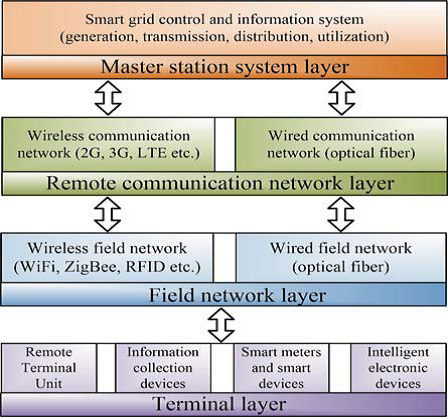
Fig.4. Four-layer architecture for IoT-in Smart Grid systems
2) Web-Enabled Smart Grid Architectures
A web-enabled architecture for Smart Grids incorporates IoT through a Web of Things framework. This framework utilizes diverse web services facilitated by various IoT devices, with web browsers serving as the interface.
Energy sources in this architecture fall into two categories: non-renewable (like coal, oil, and nuclear power) and renewable (such as hydroelectric, wind, solar, geothermal, tidal, biogas, and biofuel). Each energy source connects to smart digital energy meters, which collect data on energy consumption.
Meter readings from both types of energy sources are aggregated by dedicated IoT gateways that consistently communicate with the smart meters. This data is updated to a server, which provides web services for these IoT devices. This web service also integrates location information for homes connected via the meters.
Users can remotely schedule and control energy sources for their homes through the web services offered by IoT devices. By connecting to various internet-enabled devices, users can manage their energy sources via a source changer controlled through IoT devices, responding to commands issued through the server.
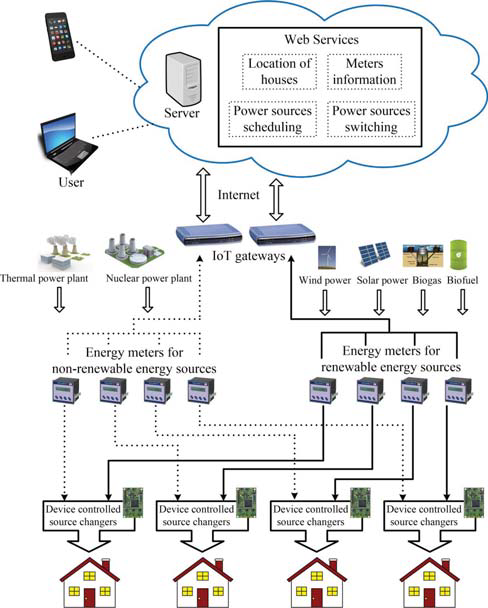
Fig.5. Web Enabled Smart Grid Architectures
V. CHALLENGES
Implementing IoT into Smart Grids presents several significant challenges. One major concern is data security, as the integration of IoT devices increases vulnerability to cyberattacks, potentially compromising sensitive consumer and operational information. Interoperability issues also arise, as different devices may utilize various communication protocols and standards, making seamless integration difficult. Additionally, managing the vast amounts of data generated by IoT devices poses challenges in storage, processing, and real-time analysis, requiring sophisticated data management solutions. Scalability becomes a concern as the number of connected devices increases, necessitating complex infrastructure adjustments. Reliability is another critical issue; the dependency on internet connectivity means that disruptions can affect grid operations, highlighting the need for robust redundancy measures. Furthermore, the initial costs associated with upgrading infrastructure and acquiring IoT devices, along with ongoing maintenance expenses, can hinder adoption. User acceptance may be impacted by resistance to new technology due to concerns over complexity and privacy, coupled with a general lack of awareness regarding the benefits of IoT integration. Navigating regulatory and compliance challenges adds another layer of complexity, as ensuring adherence to energy management and data security standards can be daunting. Lastly, environmental factors, such as extreme weather, can influence the performance of IoT devices and overall grid reliability. These challenges underscore the complexities involved in effectively integrating IoT technology into Smart Grid systems, necessitating careful planning and management.
Conclusion
In conclusion, the integration of IoT technology into Smart Grids holds transformative potential for energy management and sustainability. By enabling real-time monitoring and control of energy resources, IoT facilitates improved efficiency, reliability, and adaptability in response to fluctuating energy demands. Despite these advantages, several challenges must be addressed to fully realize the benefits of this integration. Issues such as data security, interoperability, data management, and user acceptance present significant hurdles that require strategic solutions and ongoing collaboration among stakeholders. Furthermore, navigating regulatory frameworks and ensuring environmental resilience are critical to establishing a robust Smart Grid infrastructure. As technology continues to advance, overcoming these challenges will be essential for developing Smart Grids that not only optimize energy use but also contribute to a sustainable and secure energy future. With careful planning and innovative approaches, IoT can play a pivotal role in shaping the next generation of energy systems, driving economic development, and supporting a greener planet.
References
[1] N. Pramudhita, R. A. Asmara, I. Siradjuddin and E. Rohadi, \"Internet of Things Integration in Smart Grid,\" 2018 International Conference on Applied Science and Technology (iCAST), Manado, Indonesia, 2018, pp. 718-722, doi:10.1109/iCAST1.2018.8751518. [2] S. Li, L. Da Xu, and S. Zhao, “The internet of things: a survey,” Inf. Syst. Front., vol. 17, no. 2, pp. 243–259, 2015. [3] R. Khan, S. U. Khan, R. Zaheer, and S. Khan, “Future internet: The internet of things architecture, possible applications and key challenges,” Proc. - 10th Int. Conf. Front. Inf. Technol. FIT 2012, pp. 257–260, 2012. [4] V. Dehalwar, R. K. Baghel, M. Kolhe. Multi-Agent based Public Key Infrastructure for Smart Grid, The 7thInternational Conference on Computer Science & Education (ICCSE 2012) July, 2012. Melbourne, Australia. [5] S. Pradeep, S. Krishna, M. S. Reddy, D. D. Sri and M. S. Sri, \"Analysis and Functioning of Smart Grid for Enhancing Energy Efficiency Using OptimizationTechniques with IoT,\" 2023 IEEE 5th International Conference on Cybernetics, Cognition and Machine Learning Applications (ICCCMLA), Hamburg, Germany, 2023, pp. 316-321, doi: 10.1109/ICCCMLA58983.2023.10346767. [6] K. Hassini, A. Fakhfakh and F. Derbel, \"IoT devices in smart grids,\" 2020 17th International Multi-Conference on Systems, Signals & Devices (SSD), Monastir, Tunisia, 2020, pp. 1086-1091, doi: 10.1109/SSD49366.2020.9364186. [7] S. M. A. A. Abir, A. Anwar, J. Choi and A. S. M. Kayes, \"IoT-Enabled Smart Energy Grid: Applications and Challenges,\" in IEEE Access, vol. 9, pp. 50961-50981, 2021, doi: 10.1109/ACCESS.2021.3067331.
Copyright
Copyright © 2025 Ajith M, Pranav Anil, Vishnu V Pavithran, Mumina K K. This is an open access article distributed under the Creative Commons Attribution License, which permits unrestricted use, distribution, and reproduction in any medium, provided the original work is properly cited.

Download Paper
Paper Id : IJRASET66933
Publish Date : 2025-02-12
ISSN : 2321-9653
Publisher Name : IJRASET
DOI Link : Click Here
 Submit Paper Online
Submit Paper Online

